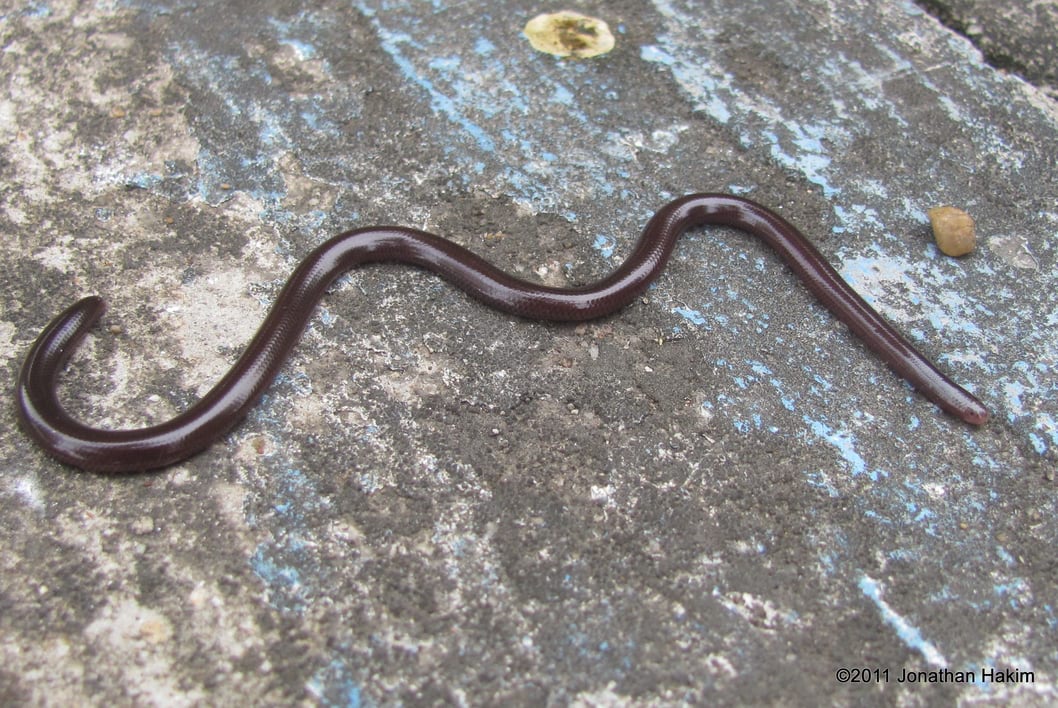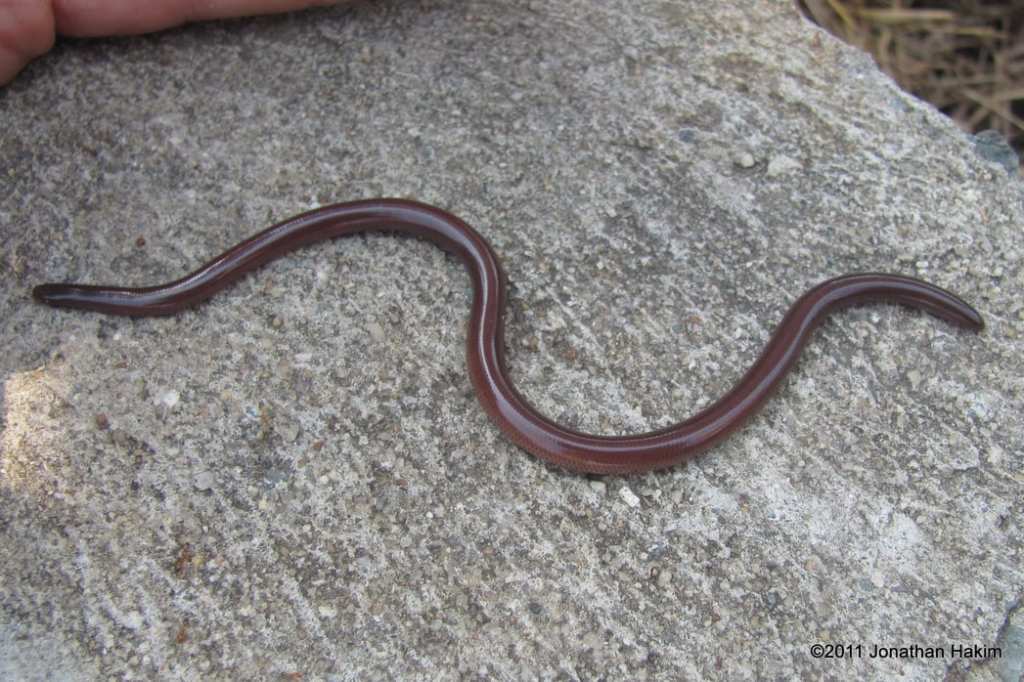Indotyphlops braminus

English name: Brahminy Blind Snake (aka “Common Blind Snake”, “Flowerpot Snake”)
Scientific name: Indotyphlops braminus (formerly Ramphotyphlops braminus)
Thai name: งูดินบาน (Ngu-din Ban)
Description: Up to 19cm long. Looks like a worm but with eyes, a flicking tongue, and small shiny scales. The mouth and eyes are so small they can be difficult to see. Slender with body length 30-45 times the body diameter. Tail comes to a point at the very end. Color is grayish-brown to almost black on top and slightly lighter below, sometimes with a lighter snout. When ready to shed their skin (such in the photo from Chatuchak above) they can appear a blueish-gray color.
Relevant scale counts: 20 rows of scales at midbody. The nasal suture goes up from the nasal and reaches the rostral on top of the head, unlike all other blind snakes (which either have nasal sutures which turn horizontal and connect to the rostral in front, or which go up but fail to reach rostral on top).
Similar Species: White-headed Blind Snake has a white head going well back of the eyes.
Slender Worm Snake is more slender and has 18 rows of midbody scales.
Flower’s Blind Snake has 18 rows of midbody scales, glands scattered around the head scales and a blunt tail tip.
Roxane’s Blind Snake is larger and more robust with lighter sides.
Ozaki’s Blind Snake has minor differences in the scales near the mouth (inferior nasal suture is in contact with 2nd supralabial instead of in contact with preocular) and in internal organs.
Blind snake species are difficult to distinguish and sometimes can only be identified by the arrangements of their tiny scales. These identifying markers can be found in this key to the blind snakes in Thailand.
Range: Originally native to southeast Asia including Thailand but now has been introduced to warm climates worldwide.
Habitat: The Brahminy Blind Snake spends its life underground, living anywhere with loose humid soil. It can be found under rocks and logs in parks, within discarded trash or buried in home gardens. On rare occasions it may be found on the surface after heavy rains.
Place in the ecosystem: This snake helps control termite and ant populations by eating their eggs and larvae, and may also eat worms. One juvenile Brahminy Blind Snake caught in Lumpani immediately regurgitated 17 ant larvae. It is eaten by larger fossorial snakes and other animals.
Danger to humans: Blind snakes are harmless – they have no venom and their mouths are too small to bite a human. When uncovered or picked up they tend to respond by wiggling vigorously, emitting a small amount of smelly musk. They also may attempt to stab the disturber with their sharp tail tip.
Conservation status and threats: Since these snakes are so small and live hidden in soil, they often are unintentionally introduced to new regions via plant and agricultural supplies. With an abundant food source, simple habitat requirements, and the ability to reproduce without males, the Brahminy Blind Snake has spread out across the world. It is now found not only in its native range in Southeast Asia but also in the Middle East, Africa, Australia, North and South America, and on islands in the Pacific. This can potentially threaten native blind snakes that are out-competed for resources. When moving natural things like plants to a different location, it is important to avoid relocating any animals.
Interesting facts: The females of this species are the only snakes in the world that can reproduce without a male (parthenogenesis). No male Brahminy Blind Snake has ever been found. The females lay up to seven tiny eggs at a time, each averaging only 4mm by 13mm.
The “Khorat Blind Snake” was once thought to be a separate species of blind snake found in central Thailand, but in 2009 Van Wallach demonstrated that the specimens were simply misidentified Brahminy Blind Snakes.
References:
Snakes of Taiwan: Ramphotyphlops braminus
Reptiles of Hong Kong: Ramphotyphlops braminus
Wikipedia: Ramphotyphlops braminus
Typhlops roxaneae, a new species of Thai blindsnake from the T. diardii species group, with a synopsis of the Typhlopidae of Thailand
A Field Guide to the Reptiles of South-East Asia
A Photographic Guide to Snakes and Other Reptiles of Peninsular Malaysia, Singapore and Thailand




Can u guide me what type the food eats blind snake…
Immediately reply pls…
Thanks
I’m sorry I didn’t see this when you posted it Bilal! The blind snakes eats ant and termite eggs, and larvae as well and perhaps occasionally the adult termites.
Thanks Dear…